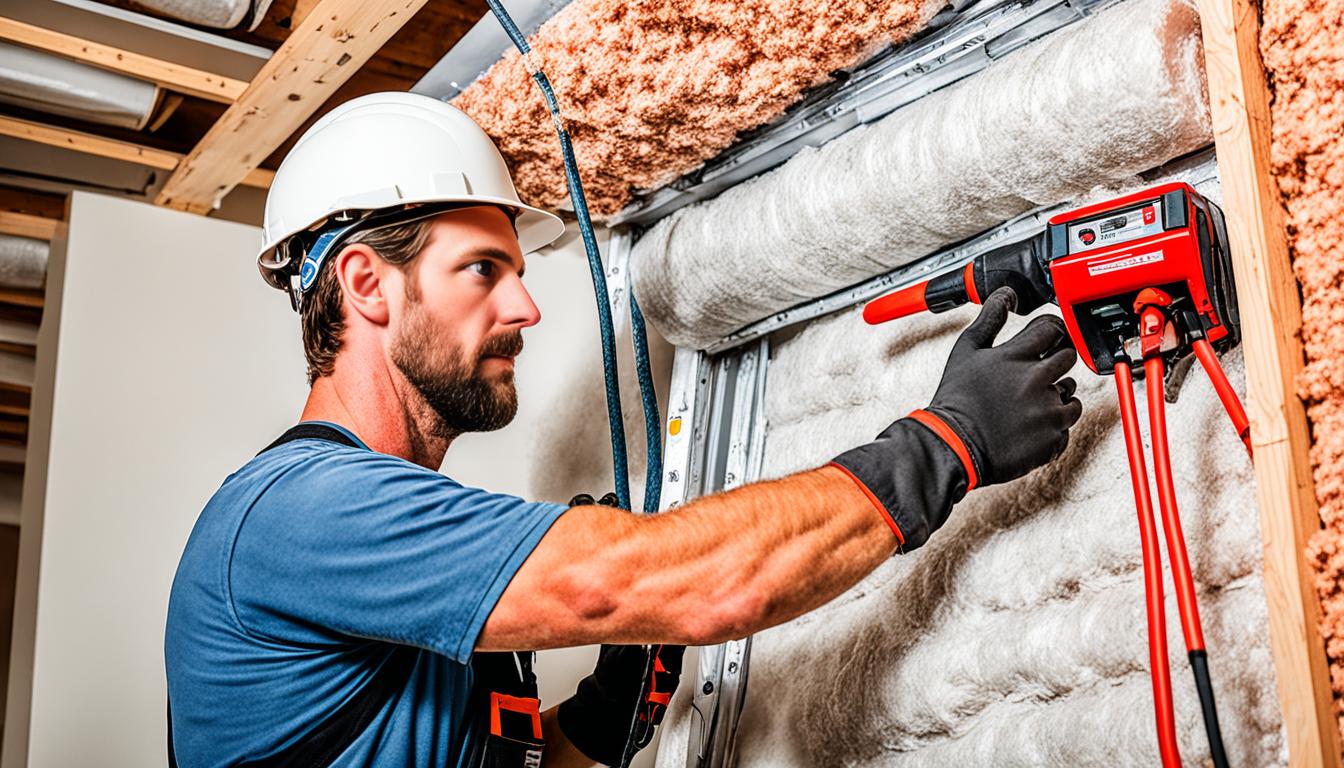Disclosure: This Post Contains Affiliate Links; We earn a commission on purchases.
When it comes to protecting your home from electromagnetic fields (EMF), choosing the right building materials is crucial. EMF radiation is present in our environment and can potentially have negative effects on our health. To safeguard your home and reduce EMF exposure, it’s important to select EMF-resistant building materials. This guide will provide you with the information you need to make informed choices and create a healthier living space.
Key Takeaways:
- EMF exposure from various sources can potentially have harmful effects on our health.
- Selecting EMF-resistant building materials can help reduce EMF exposure in your home.
- Radio frequency-blocking materials like Aluminum RF Shielding Foil and G-iron ArmoFlex can be used to protect against exterior sources of EMF radiation.
- Different types of radiation require specific shielding materials, such as lead for x-rays and gamma radiation.
- Implementing field management plans and following guidelines can effectively reduce EMF exposure in buildings.
Understanding EMF and Its Impact on Health
Electromagnetic fields (EMF) are generated by various sources in our environment, including power lines, electronic devices, and household appliances. While EMF is natural, prolonged exposure to high levels of EMF can potentially have harmful effects on our health.
Reducing EMF exposure in buildings is crucial, especially in areas where people spend a significant amount of time. By choosing EMF-safe construction materials and implementing effective strategies, you can minimize the risks associated with EMF radiation and create a healthier living space.
How to reduce EMF exposure in buildings:
- Choose EMF-safe construction materials: Look for materials that have been specifically designed to reduce EMF exposure. These materials are often made with shielding properties that block or absorb EMF radiation.
- Optimize the layout of electronic devices: Arrange electronic devices in a way that minimizes their proximity to living spaces. Keep devices like Wi-Fi routers, cordless phones, and baby monitors away from bedrooms and areas where you spend a significant amount of time.
- Use shielding products: Install EMF shielding products in vulnerable areas, such as windows and walls facing power lines or other strong sources of EMF radiation. These products can help block or redirect EMF radiation, reducing exposure.
- Create EMF-free zones: Designate certain areas within your home as EMF-free zones, where electronic devices and wireless signals are limited or eliminated. This can be especially beneficial in bedrooms and spaces reserved for rest and relaxation.
- Limit wireless technology usage: Reduce your reliance on wireless technologies, such as Wi-Fi and Bluetooth. Use wired connections whenever possible, and turn off wireless devices when they’re not in use.
“Reducing EMF exposure is an essential step in safeguarding our health and well-being. By implementing simple yet effective strategies, we can create EMF-safe environments that promote a healthier lifestyle.”
Remember, every effort to reduce EMF exposure matters. By making informed choices and implementing practical solutions, you can prioritize the well-being of yourself and your loved ones.
Next, let’s explore how specific shielding materials can help protect against radio frequency EMF radiation and provide effective insulation.
EMF-Resistant Building Materials for Radio Frequency Protection
Radio frequencies are a common source of EMF radiation. To protect your home from exterior sources of radio frequency exposure, there are specific building materials that can be used as effective barriers.
One such material is Aluminum RF Shielding Foil, which is designed to be installed during construction and renovation. This foil can be placed under drywall, plaster, stucco, rooftops, and attic spaces. It acts as a shield against radio frequencies, reducing the level of exposure in your home.
Another excellent option is G-iron ArmoFlex, an EMF blocker specifically designed for AC Magnetic Fields produced by electrical current. This flexible material retains its shielding properties even when bent or molded, making it suitable for various shielding applications.
Comparison of EMF-Resistant Building Materials for Radio Frequency Protection
| Building Material | Features |
|---|---|
| Aluminum RF Shielding Foil | Designed for installation during construction or renovation. Can be placed under various surfaces, such as drywall, plaster, and rooftops. |
| G-iron ArmoFlex | Flexible material that maintains shielding properties even when bent or molded. Specifically designed for AC Magnetic Fields produced by electrical current. |
By incorporating these EMF-resistant building materials into your home, you can create a safer environment with reduced radio frequency exposure.

Shielding Materials for Different Types of Radiation
Different types of radiation require different types of shielding materials to effectively protect against exposure. The choice of shielding material depends on the specific radiation being dealt with. Let’s explore some common options:
1. Lead Shielding
Lead is widely used as a shielding material for x-rays and gamma radiation due to its high density and atomic number. It effectively absorbs and attenuates these types of radiation, providing reliable protection. Lead can be incorporated into building materials like concrete and cinder blocks to create a radiation-safe environment.
2. Flexible Lead Vinyl Films
Flexible lead vinyl films are another versatile option for shielding against radiation. These films can be layered to the desired thickness and used as wearable shields. They are commonly used in the medical field for aprons and other protective gear.
3. Pure Lead Products
Pure lead can be fabricated into various product forms, such as sheets, plates, and foils, offering flexibility in shielding applications. These products are effective for creating barriers against radiation in specific areas, such as walls, floors, or ceilings.
4. Lightweight Radiation Shielding Products
For applications that require lightweight shielding, products like Demron® are an excellent choice. Demron® is a radiation-blocking material that can be used in hazmat suits, blankets, and other personal protection products. Its lightweight nature makes it suitable for various scenarios requiring mobility.
“Choosing the right shielding materials is essential for protecting against different types of radiation exposure.” – Dr. Emily Thompson, Radiation Protection Expert
It’s important to note that while these materials provide effective shielding, it’s crucial to work with professionals and ensure that the shielding is installed correctly to maximize their effectiveness.

Shielding Techniques for Different Types of Radiation
The effectiveness of shielding materials varies depending on the type and energy of radiation. When it comes to protecting against x-rays and gamma radiation, lead is the top choice due to its high atomic number.
For shielding against high-energy beta particles, commonly used materials include plastic, wood, water, and acrylic glass. These materials are effective in blocking and attenuating beta radiation.
When it comes to shielding against neutron radiation, boron and cadmium are known neutron absorbers. These materials are often utilized for their ability to absorb and attenuate neutron radiation.
It’s important to choose shielding techniques and materials based on their specific properties and their ability to block or attenuate radiation. Consider the type of radiation you are dealing with and select the appropriate shielding materials accordingly to ensure optimal protection against electromagnetic fields (EMF).
| Type of Radiation | Shielding Material |
|---|---|
| X-rays and Gamma Radiation | Lead |
| High-Energy Beta Particles | Plastic, Wood, Water, Acrylic Glass |
| Neutron Radiation | Boron, Cadmium |
By understanding the different types of radiation and the appropriate shielding techniques, you can effectively protect yourself and your home from electromagnetic fields. Choose the best shielding materials for EMF based on their proven effectiveness in blocking and attenuating radiation. Ensuring low EMF exposure is essential for creating a safe and healthy living environment.
Field Management Plans for EMF Reduction
Implementing field management plans is an effective way to reduce EMF exposure in buildings. These plans involve the selection and implementation of “no-cost and low-cost” magnetic field reduction measures. The California Public Utilities Commission (CPUC) has provided guidelines for reducing magnetic fields near electric power lines. These guidelines include methods for reducing magnetic fields, such as conductor spacing, phasing, and magnetic field modeling. By following these guidelines and implementing field management plans, homebuilders can effectively reduce EMF exposure in their properties.
Reducing EMF exposure in homes and buildings is a significant concern for many homeowners, especially those who are sensitive to electromagnetic radiation. Field management plans provide practical strategies to minimize EMF levels and create a safer living environment. By incorporating these plans into the construction process, homebuilders can proactively address EMF-related health risks.
Guidelines for Reducing Magnetic Fields
The CPUC guidelines for reducing magnetic fields near electric power lines offer valuable insights into effective EMF protection strategies. Here are some key methods recommended by the CPUC:
- Conductor Spacing: Increasing the distance between power lines and nearby buildings can help reduce magnetic field exposure. By opting for wider separation during construction, homebuilders can effectively mitigate EMF levels.
- Phasing: Properly phasing power lines can also contribute to magnetic field reduction. The CPUC guidelines outline specific phasing techniques that can be implemented to minimize EMF exposure.
- Magnetic Field Modeling: Conducting magnetic field modeling studies helps to identify potential areas of concern and plan effective mitigation strategies. Homebuilders can engage professionals to perform these studies and ensure optimal EMF reduction in their properties.
By combining these strategies with the selection of EMF insulation products, homebuilders can create homes that offer enhanced protection against electromagnetic radiation.
Implementing field management plans is crucial for reducing EMF exposure in homes and buildings. By following established guidelines and incorporating low-cost measures, homebuilders can minimize the risks associated with electromagnetic radiation. Taking proactive steps towards EMF protection can result in healthier living spaces for occupants.
Table: Comparing Different EMF Insulation Products
| Insulation Product | Features | Benefits |
|---|---|---|
| G-iron ArmoFlex | Designed for AC Magnetic Fields | Provides effective shielding against electrical current-induced magnetic fields |
| Aluminum RF Shielding Foil | Shielding against Radio Frequencies | Reduces exposure to exterior sources of radio frequency radiation |
Source: Adapted from manufacturer specifications and customer reviews.
California Department of Education’s Standards for Siting New Schools Adjacent to Electric Power Lines
The California Department of Education has established rigorous standards for the siting of new schools near electric power lines rated 50 kV and above. These standards are designed to minimize EMF exposure for students and staff, ensuring a safe and healthy learning environment. By following these guidelines, homebuilders can incorporate low EMF materials and techniques into their construction projects, prioritizing the well-being of inhabitants and providing effective EMF protection for homes.
According to the California Department of Education, “no-cost and low-cost” measures should be implemented during the distribution projects to reduce magnetic fields. These measures may include the strategic use of shielding materials alongside meticulous planning of the electrical facility layout. (1)
Here are some key recommendations:
- Use shielding materials to create an effective barrier against EMF radiation.
- Plan the electrical facility layout carefully to minimize EMF exposure.
- Consider the use of low EMF materials to construct the school buildings.
- Ensure compliance with all applicable regulations and safety standards.
“By implementing these guidelines, school administrators and builders can create a safer environment for students and staff, protecting them from potential risks associated with high levels of EMF exposure.”
Homebuilders can adopt these standards and recommendations to construct residential properties with low EMF materials. By doing so, they contribute to the well-being of occupants and provide a safer living space. It’s important to stay informed about the latest guidelines and regulations to ensure that homes are built with the highest standards of EMF protection. With careful planning and adherence to these standards, builders can create homes that prioritize the health and safety of residents.
| Benefits of Following California Department of Education’s Standards for Siting New Schools Adjacent to Electric Power Lines | Key Considerations |
|---|---|
| Enhanced safety and well-being for students and staff | Identify electrical facility layout |
| Reduced EMF exposure | Use of shielding materials |
| Compliance with regulatory standards | Selection of low EMF materials |
Benefits and Considerations of Following the California Department of Education’s Standards
By adhering to the California Department of Education’s standards for siting new schools adjacent to electric power lines, homebuilders can ensure that their construction projects prioritize EMF protection for homes. This not only safeguards the health and well-being of the future residents but also sets a higher standard of safety and compliance in the construction industry.
Stay tuned for the next section, where we will conclude with key takeaways on how to choose EMF-resistant building materials and create a healthier living space.
Conclusion
Choosing EMF-safe construction materials is essential for homeowners and builders who want to reduce exposure to electromagnetic fields (EMF) and create a healthier living environment. By understanding the impact of EMF on health and selecting suitable shielding materials for different types of radiation, it is possible to effectively minimize EMF exposure in buildings.
To start, being aware of the potential health risks associated with prolonged EMF exposure is crucial. By prioritizing the health and well-being of occupants, builders can make informed choices when selecting building materials that provide adequate protection against EMF radiation.
Additionally, implementing field management plans can further reduce EMF exposure in buildings. These plans involve the use of low-cost and no-cost magnetic field reduction measures. By following guidelines provided by reputable organizations and implementing these measures, builders can create homes that prioritize EMF protection.
In summary, reducing EMF exposure in buildings is achievable by choosing the right construction materials, understanding the effects of EMF on health, and implementing effective field management plans. Staying informed about the latest guidelines and recommendations for EMF protection is essential for builders and homeowners who want to create EMF-safe living spaces.
Source Links
- https://www.radetco.com/your-complete-guide-materials-that-block-radiation/
- https://safelivingtechnologies.com/building-material-shielding/
- http://www.cpuc.ca.gov/environment/info/aspen/dpv2/deir/apps/ap6_emf_design_guidelines.pdf

Subscribe to Our Newsletter










